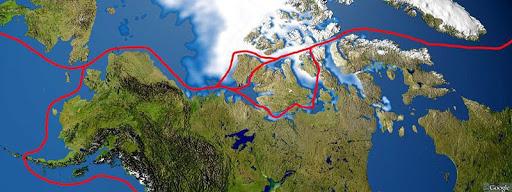Northwest Passage: Then and Now
In this lesson, students learn about some of the early explorations of the Northwest Passage, and how the changing sea ice extent has prompted new explorations of this region to transport goods from one region of the Northern Hemisphere to another.
Context for Use
Project EXTREMES lessons were intended to be stand alone lessons.

Map of the Northwest Passage. Credit: www.serc.carlton.edu
Goals Header
What Students Will Do
-
Use datasets displayed in Google Earth Pro to identify trends in Arctic sea ice extent.
-
Create evidence-based arguments for changing sea ice extent.
-
Discuss the economic implications for the loss of sea ice in the Arctic.
Teaching Materials
User note: To make an editable copy of the teaching materials in Google Drive, select File > “Make a copy”. This will make a copy for you to save to your own drive and edit as you see fit.
Description
This lesson plan was adapted in part from material from the Northwest Passage exercise from On the Cutting Edge available at: https://serc.carleton.edu/sp/library/google_earth/examples/northwest_passage.html.
-
Activity 1 – Engage (30 minutes) Moving Goods in the Northern Hemisphere
Students will read a short text on the Northwest Passage.
-
Activity 2 – Explore (50 minutes) Contemporary Northwest Passages
Students explore the Arctic using Google Earth Pro, and read a series of articles on changing sea ice extent.
-
Activity 3 – Explain (20 minutes) Arctic Sea Ice Today - Causes and Effects
Students participate in a whole-class discussion about their findings, and consider the possible effects of reduced sea ice in the Arctic
-
Activity 4 – Evaluate (20 minutes) Transporting Oil Today
Students use their experiences from the lesson to create and present a solution for moving oil from the Arctic region to other regions around the world.




